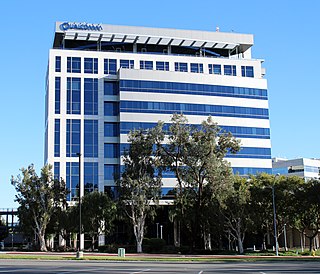
Telefonaktiebolaget LM Ericsson, commonly known as Ericsson, is a Swedish multinational networking and telecommunications company headquartered in Stockholm. The company sells infrastructure, software, and services in information and communications technology for telecommunications service providers and enterprises, including, among others, 3G, 4G, and 5G equipment, and Internet Protocol (IP) and optical transport systems. The company employs around 100,000 people and operates in more than 180 countries. Ericsson has over 57,000 granted patents.

STMicroelectronics N.V. is a multinational corporation and technology company of French-Italian origin. It is headquartered in Plan-les-Ouates, Switzerland and listed on the New York Stock Exchange, on the Euronext Paris in Paris and on the Borsa Italiana in Milan. ST is the largest European semiconductor contract manufacturing and design company. The company resulted from the merger of two government-owned semiconductor companies in 1987: Thomson Semiconducteurs of France and SGS Microelettronica of Italy.

Qualcomm Incorporated is an American multinational corporation headquartered in San Diego, California, and incorporated in Delaware. It creates semiconductors, software, and services related to wireless technology. It owns patents critical to the 5G, 4G, CDMA2000, TD-SCDMA and WCDMA mobile communications standards.

Nordic Semiconductor ASA was founded in 1983 and is a Norwegian fabless technology company with its headquarters in Trondheim, Norway. The company specializes in designing ultra-low-power wireless communication semiconductors and supporting software for engineers developing and manufacturing Internet of Things (IoT) products.

OMAP is a family of image/video processors that was developed by Texas Instruments. They are proprietary system on chips (SoCs) for portable and mobile multimedia applications. OMAP devices generally include a general-purpose ARM architecture processor core plus one or more specialized co-processors. Earlier OMAP variants commonly featured a variant of the Texas Instruments TMS320 series digital signal processor.

Ericsson Mobile Platforms (EMP) was the name of a company within the Ericsson group that supplied mobile platforms, i.e. the technological basis on which a cellular phone product can be built. The main office was in Lund, Sweden.

Telit Cinterion is an Internet of Things (IoT) Enabler company headquartered in Irvine, California, United States. It is a privately held company with key operations in the US, Brazil, Italy, Israel, and Korea.

NXP Semiconductors N.V. (NXP) is a Dutch semiconductor designer and manufacturer with headquarters in Eindhoven, Netherlands. The company employs approximately 31,000 people in more than 30 countries. NXP reported revenue of $11.06 billion in 2021.

Nomadik is a family of microprocessors for multimedia applications from STMicroelectronics, and later ST-NXP Wireless. It was originally based on the ARM9 ARM architecture(s), and was designed specifically for use in mobile devices.

MediaTek Inc. is a Taiwanese fabless semiconductor company that provides chips for wireless communications, high-definition television, handheld mobile devices like smartphones and tablet computers, navigation systems, consumer multimedia products and digital subscriber line services as well as optical disc drives.
LDMOS is a planar double-diffused MOSFET used in amplifiers, including microwave power amplifiers, RF power amplifiers and audio power amplifiers. These transistors are often fabricated on p/p+ silicon epitaxial layers. The fabrication of LDMOS devices mostly involves various ion-implantation and subsequent annealing cycles. As an example, the drift region of this power MOSFET is fabricated using up to three ion implantation sequences in order to achieve the appropriate doping profile needed to withstand high electric fields.
In telecommunications, long-term evolution (LTE) is a standard for wireless broadband communication for mobile devices and data terminals, based on the GSM/EDGE and UMTS/HSPA standards. It improves on those standards' capacity and speed by using a different radio interface and core network improvements. LTE is the upgrade path for carriers with both GSM/UMTS networks and CDMA2000 networks. Because LTE frequencies and bands differ from country to country, only multi-band phones can use LTE in all countries where it is supported.

The ARM Cortex-A9 MPCore is a 32-bit multi-core processor that provides up to 4 cache-coherent cores, each implementing the ARM v7 architecture instruction set. It was introduced in 2007.
Sony Semiconductor Israel Ltd., formerly known as Altair Semiconductor, is an Israeli developer of high performance single-mode Long Term Evolution (LTE) chipsets. The company's product portfolio includes baseband processors, RF transceivers and a range of reference hardware products. Founded in 2005, Altair employs 190 employees in its Hod Hasharon, Israel headquarters and R&D center, and has regional offices in the United States, Japan, China, India, Finland, and France. Altair Semiconductor was the first chipset vendor to receive certification from Verizon Wireless to run on its 4G LTE network. Altair has also powered several devices launched on Verizon's network including the Ellipsis 7 tablet and HP Chromebook 11.6"LTE. In January 2016, it was announced that Sony was acquiring Altair for $212 Million. Altair was renamed Sony Semiconductor Israel on March 29, 2020.

The Samsung Exynos, formerly Hummingbird (Korean: 엑시노스), is a series of ARM-based system-on-chips developed by Samsung Electronics' System LSI division and manufactured by Samsung Foundry. It is a continuation of Samsung's earlier S3C, S5L and S5P line of SoCs.

NovaThor was a platform consisting of integrated System on Chips (SoC) and modems for smartphones and tablets developed by ST-Ericsson, a 50/50 joint venture of Ericsson and STMicroelectronics established on February 3, 2009. ST-Ericsson also sold the SoCs (Nova) and the modems (Thor) separately. The application processor portion of the system was the successor of the previous Nomadik line from STMicroelectronics.

Ericsson Mobile Communications AB was a subsidiary of Ericsson, entirely focused on development of mobile phones (handsets), which has been fully acquired by Sony Corp. in 2011. This concluded tumultuous and unhappy venture between the two electronic giants The major offices were located in Lund, Kumla, Raleigh, North Carolina and Lynchburg, Virginia.
Sequans Communications is a fabless semiconductor company that designs, develops, and markets integrated circuits ("chips") and modules for 4G and 5G cellular IoT devices. The company is based in Paris, France with offices in the United States, United Kingdom, Israel, Hong Kong, Singapore, Taiwan, South Korea, Finland and China. The company was founded as a société anonyme in October 2003 by Georges Karam. It originally focused on the WiMAX market and expanded to the LTE market in 2009, dropping WiMAX altogether in 2011. Today the company develops and delivers only LTE chips and modules for the global 5G/4G cellular IoT market. Sequans was listed on the New York Stock Exchange in April 2011. Karam is the company's CEO.
Nexperia was the NXP Semiconductors brand for a family of processors, primarily featuring media processor system-on-chip (SoC) and media co-processors, but also briefly including highly integrated mobile (SoC) products.
ST-NXP Wireless was a joint venture made up of the wireless operations of STMicroelectronics and NXP Semiconductors, existing between 2008 and 2009.












